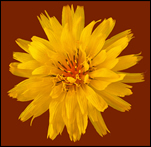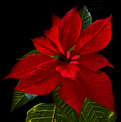

Red Jasmine ∞ Jasminum beesianum
Great Yellow Bumblebee ∞ Bombus distinguendus
By a shore of Loch Morar on the west coast of Scotland
• 24 June 2013
Photograph by Mark O
By Mark O
Posted on 1 August 2013
It is always a pleasure to see the green leaves of the Jasmine shrub begin to bud and then flower like this Red Jasmine.
When in full bloom the bees start to arrive… at first I may only see three or four. The next day more arrive… and within a few days the entire shrub is buzzing with the sound of the aptly named busy bees.
As I stroll around the garden early in the morning with coffee in hand, taking in the sights, sounds, and scents of a beautiful summer's morning, the bees have already started their day and offer many photo opportunities over the course of the day. Unlike the bees, I like to take my time to enjoy watching them before finally taking my camera out to capture one at work… as the photo shows.
When the flowers start to fade on the Red Jasmine, the White Jasmine next to it is already starting to open its buds… and the pleasure of both plant and bees starts over again. That is the joy of summer. That is the joy of nature.
∞
How lovelily the Jasmine flower
Blooms far from man's observing eyes ;
And having lived its little hour
There withers,—there sequester'd dies !
Though faded, yet 'tis not forgot ;
A rich perfume time cannot sever
Lingers in that unfriended spot,
And decks the Jasmine's grave for ever !
— By Ryan | from the poem "On The Indian-Jasmine Flower," mid-19th century
∞
Legend of the Jasmine and the Bride
Jasmine ... is of exquisite fragrance. Its distribution throughout Europe is curious. It is related that about the year 1700 the plant, though formerly known, had become lost to European gardens, except to that of the Grand Duke of Tuscany, who desirous to be the sole possessor of so beautiful a plant forbade his gardener to give away any suckers or sprigs to other gardeners.
The gardener, however, without reflecting on the consequence, presented to the fair, but portionless damsel of his affections, upon her birth-day a nosegay of choice flowers, and among others a sprig of Jasmine. The young maiden, to preserve the freshness of this pretty stranger, placed it in the earth. It fortunately grew and flourished, and planting other slips, taken from this, she was enabled to supply an increasing demand, and thus to amass a little fortune, which she bestowed with her hand upon the gardener of her heart.
The girls of Tuscany, in remembrance of this adventure, always deck themselves on their wedding day, with a nosegay of Jasmine, real or artificial, as ladies in England do with orange blossoms, and they have a proverb that she who is worthy to wear Jasmine flowers is a fortune to her husband.
from The Favorites of the Flower Garden, Arranged According to the Natural System of Botany (p.115) | By George William Francis | Simpkin, Marshall, & Co., Stationers | London 1844
Hover and Collect was posted on Thursday, August 1, 2013
![]() Bumblebees: Naturally Scottish
Bumblebees: Naturally Scottish
"What is special about Bumblebees?" author Murdo Macdonald asks in his Introduction to this excellent monograph about bummiebees of Scotland. With wit and knowledge, Mr. Macdonald answers his question skillfully and thoroughly. The several photographs of bummies native to Scotland are sharp and often beautiful. Bumblebees: Naturally Scottish is a nicely done piece of work published by Scottish Natural Heritage.
![]() Bumblebees on the edge
Bumblebees on the edge
Subtitled "A guide to habitat management for bumblebees in north and west Scotland," the information is useful for most any place on Planet Earth. You can learn about six species of bumblers native to the north and west of Scotland. The web is a .pdf brochure published by RSPB Scotland and the Bumblee Conservation Trust.
Mark O
You can reach Mark O by e-mail at lord.orior@gmail.com









